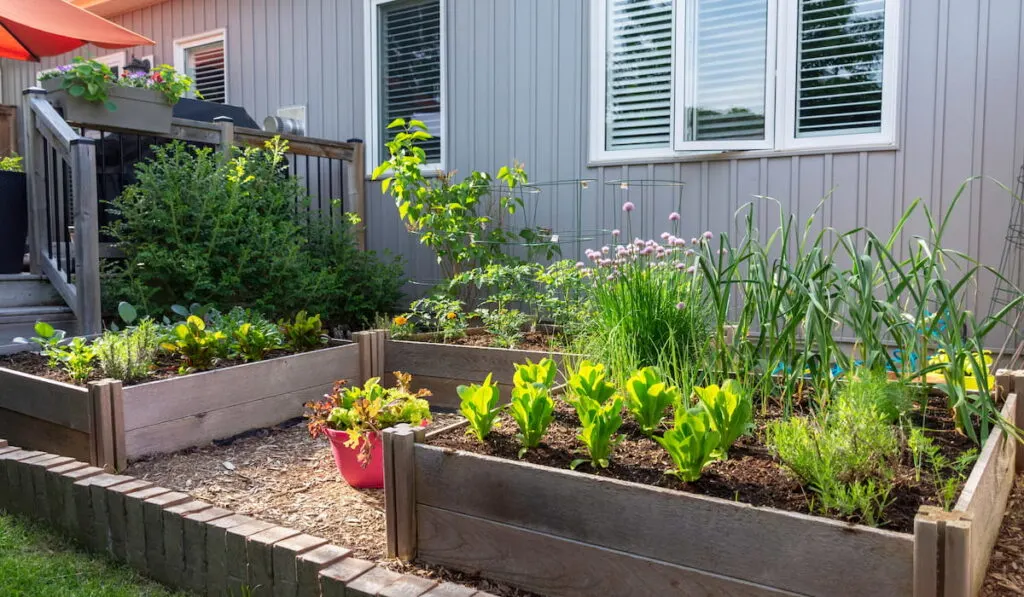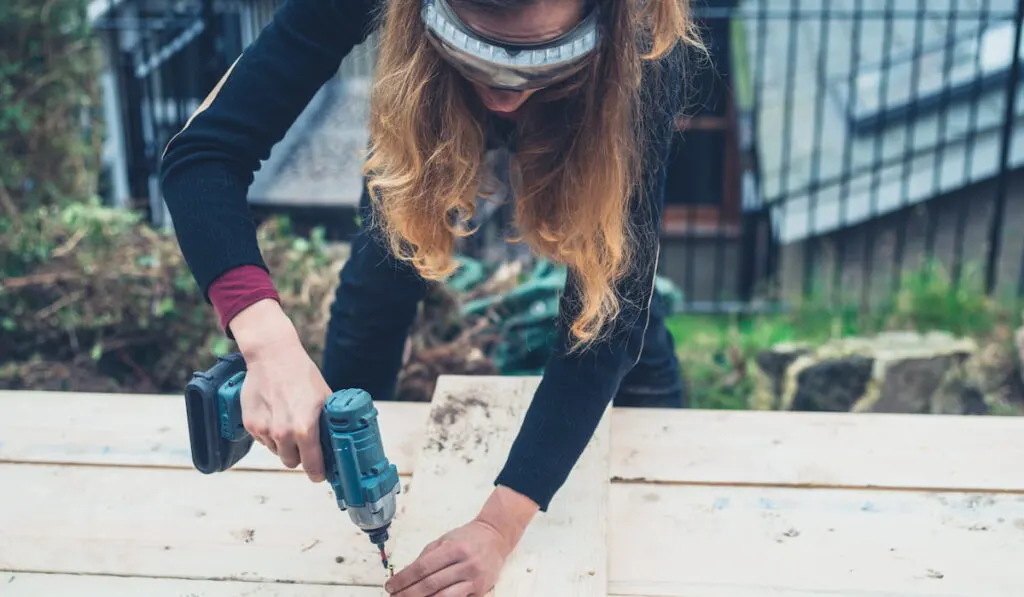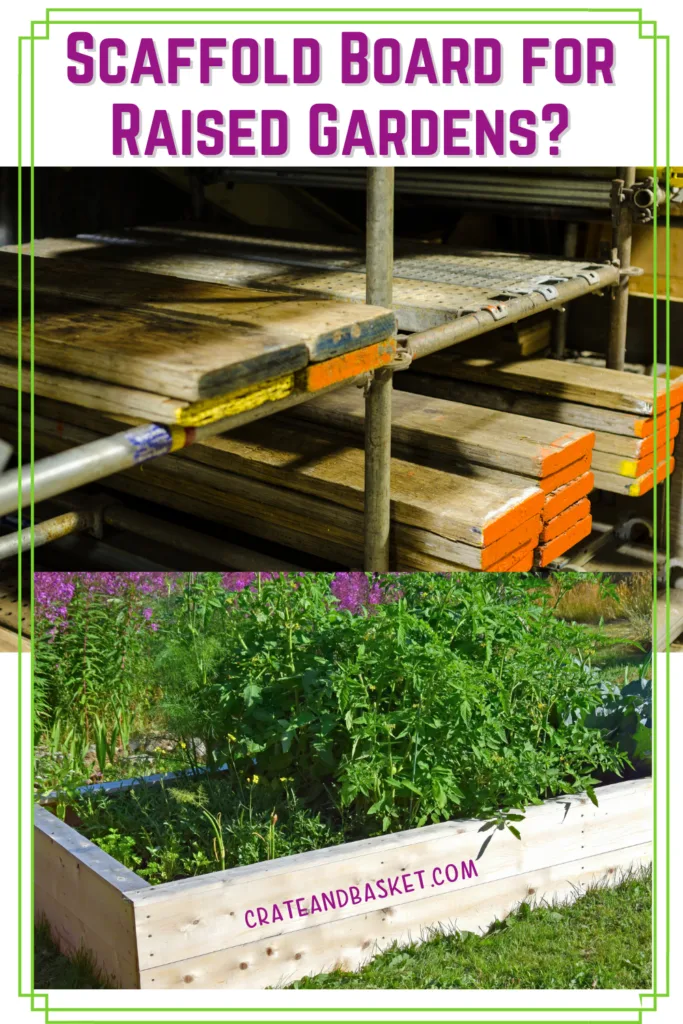Raised bed gardening has become a popular method for growing anything from decorative plants to a vegetable garden.
The raised bed garden has become so popular that some companies produce raised garden bed kits, but these are usually made of plastic and are quite expensive.
A DIY approach would be a better option for your raised bed. So, what materials can you use for the raised bed construction?
Can you use scaffolding boards to build your raised bed?
It is possible to use scaffolding boards for a raised bed vegetable garden, but with some provisions taken into account. Do not use CCA treated boards; this chemical is toxic. ACQ and CA-B treated boards are safe to use, but you can line the inside with food-grade plastic sheets for peace of mind.

There are many varieties of material that can be re-purposed for the construction of a raised garden bed.
One of the materials often used is timber. The concern with timber is usually around durability and how it would fare in the moist environment of a garden bed.
Does timber make for a good, raised bed construction material, and does scaffold board fall into this category?
Table of Contents
Can Scaffold Boards Be Used For Raised Beds?
Scaffold boards can be re-purposed for the construction of your raised garden bed.
There are a number of characteristics of scaffold board that make it suitable for this purpose, but there are also a few potential problems that you need to watch out for.
These are some of the characteristics of scaffold boards that make them a great constriction material for raised beds.
- The wood has been seasoned. Scaffold boards are usually seasoned wood, which a combination of a drying and treatment process that makes the wood hard, durable, and resistant to weather damage.
- The dimensions of the scaffolding. The boards are usually long, wide and thick, which will give you more options for the size of garden bed you want to make without having to join boards together for a long raised bed. The thickness of the boards can be 1.5-inches, 2-inches or 2.5-inches. The width of the boards is usually 9 or 10-inches. The lengths can vary from 6 feet to 12 feet, which gives you a good number of options on bed sizes.
- Readily available. Scaffold boards are replaced by scaffold companies on a regular basis since they become a health and safety issue if they develop a crack or start to warp. These reject boards are then sold off as scrap at a fairly low price.
Scaffold boards are tough and durable, made to be used and abused in the construction industry.
Even after they have been deemed unusable for this purpose, they are still a sought after material for raised beds.

Damaged ends and undesirable sections can be cut and trimmed to still get boards of usable length from the plank.
What Problems Occur With Scaffolding Board Raised Beds?
So what are the potential problems with using scaffold boards for raised beds?
One of the biggest concerns is the treatment used to preserver the boards. Older boards were treated with a product called CCA, which is chromate copper arsenate.
CCA treated boards were deemed unfit for use for residential purposes by the EPA in 2003 because the arsenic can leech out of the boards and become a health hazard.
Because of this, CCA treated boards are also not suitable for raised garden beds. The arsenic can leech out of the boards and into the soil.
Since that time, these boards are now treated with ACQ and CA-B, which both include copper as an insect repellant and a fungicide to prevent fungi in soil from attacking the wood.
The arsenic component, however, has been removed.
There are, however, still some old CCA treated boards around, so you will need to make sure the boards you acquire have been made after 2003 and check them for any markings on the board that could indicate CCA treatment.
If you are concerned about your timber, you can line the inside of the wood with a heavy-duty plastic that is intended for use in the garden.
This is the recommended method for making timber raised garden beds intended for growing certified organic vegetables.

Where Can I Source Scaffolding Boards?
Scaffolding boards can be sourced quite easily from companies that rent out or supply scaffolding equipment to the building and construction industry.
If there is no such company in close proximity to your location, you can perform an internet search for used scaffolding boards in your area.
Construction companies that source their own scaffolding will often be quite happy for you to come and remove their pile of old scaffolding boards and clear up some space for them.
You can also stop in at active construction sites and ask the project manager for any old boards that they are no longer using. Often these boards simply get dumped or even left on-site when the construction crew leaves.
Just remember to never take scaffolding boards from a site without asking first. This could get you into some trouble.
Can Other Materials Be Used For A Raised Bed?
Scaffolding boards are popular as a material for raised bed gardens, but there are other materials that work well as substitutes should you not be able to source these boards
- Other timber. You can buy timber from your local timber yard and have it cut to size for your raised bed. The best timber to use is cedar because of its natural resistance to insects and the weather. Pine can also be used, and it is a relatively cheap wood. Coat the timber on both sides with boiled linseed oil, and the boards will last a long time. The advantage of this is that the wood is not treated with any potentially toxic chemicals.
- Bricks and cement. Building a brick and cement wall for your raised beds makes a solid structure that will last a long time.
- Corrugated roof sheeting. Corrugated iron roof sheeting is a good material to use for your raised bed that is bot durable and fairly cheap. You can make wood corner posts to fix the corrugated iron to, and you will need to put in stakes across the length of the bed to support the sheets. This will stop them from bowing out when you fill them with soil.
- Natural rock. If you have a lot of rocks on your property, stack them up to build your raised bed. You can even cement them together to make the structure more robust.

Materials To Avoid For Your Raised Bed
Of course, you should avoid any pressure treated wood that used CCA in the process.
There are a number of other materials that you should avoid using for your raised garden bed.
- Timber treated with creosote. Creosote is a concoction of many chemicals that can be toxic and harmful to your health.
- Railroad ties. Railroad ties, or railroad sleepers, have usually received treatment with products that are harmful and should not be used to build your raised bed.
- Pallet wood. Some pallet wood can be used to build your raised bed, and some should not. It all depends on the treatment that was used on the pallet wood. Similar to scaffold boards, some are treated with harmful chemicals and pesticides. The ones that are indicated with HT for heat treatment are fine to use, but if you see any other markings on the wood other than this, rather don’t use the wood for your garden.
- Cinder blocks. Some cinder blocks that are made of cement are fine to use, but if the cinder block is made from fly ash, it contains dangerous heavy metals and toxins and should not be used.
- Old tires. Heavy metals are used in the manufacture of tires, and the concern is that these toxins may leech out into the soil. This is somewhat of a controversial point since there is one school of thought that the rubber binds the heavy metals and prevents them from leaching out. It would be best to not take the chance with your health and rather avoid using tires.

Conclusion
While it is fine to use scaffolding boards for a raised garden bed, there are some precautions that you need to observe to make sure the boards are safe to use.
If the boards are treated with CCA, do not use them. If the boards are treated with ACQ or CA-B, they are safe to use, but your vegetables would not be considered organic.
You can get around this by lining the inside of the wood, the part that will be in contact with the soil, with plastic that is designated for use in food gardens.
Scaffolding boards make good robust material for making your raised garden bed and should last 4 to 5 years, depending on your local conditions, before they need to be replaced.

